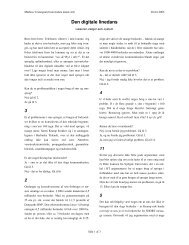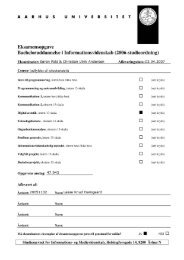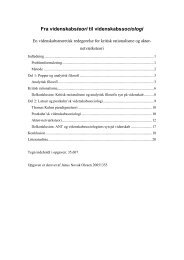Semiotics, Fashion and Cognition - Mathias Vestergaard Corp.
Semiotics, Fashion and Cognition - Mathias Vestergaard Corp.
Semiotics, Fashion and Cognition - Mathias Vestergaard Corp.
Create successful ePaper yourself
Turn your PDF publications into a flip-book with our unique Google optimized e-Paper software.
<strong>Mathias</strong> <strong>Vestergaard</strong> Jakobsen <strong>Semiotics</strong>, <strong>Fashion</strong> an <strong>Cognition</strong> 2008-06-11<br />
the fashion changes itself. This system of constant renewal <strong>and</strong> spreading of taste is more abstract<br />
but still coherent with Barthes’ view, when he proposes that there is a shared system of rules for<br />
dressing – what he terms ‘dress’.<br />
Clothing is a physical thing. Knitted yarns <strong>and</strong> woven fabrics sewed together <strong>and</strong> trimmed with<br />
b<strong>and</strong>s, broidery or buttons, forming actual pieces of wearable clothing. The act of putting on<br />
clothes is the act of ‘dressing’. A garment is a single piece of clothing. An outfit is a composition of<br />
several garments into a whole.<br />
Style or ‘personal style’ is often closely linked to fashion, <strong>and</strong> the terms are often used almost<br />
interchangeably, but style is more of a continuous personal project, whereas fashion is the shared<br />
agreement of taste.<br />
Language will be defined broadly as a system of communication.<br />
Section A. Barthes’s clothing <strong>and</strong> fashion theory<br />
Rol<strong>and</strong> Barthes’s theory of fashion developed throughout his career, however, in this section only<br />
the early semoilogically inspired view on clothing, as he describes it in the essays ‘History <strong>and</strong><br />
sociology of clothing : some methodological observations’ (2006, pp. 3-20), ‘Language <strong>and</strong><br />
clothing’ (2006, pp.21-32) <strong>and</strong> ‘Towards sociology of dress’ (2006, pp. 33-40) will be taken into<br />
account. Inspired by Ferdin<strong>and</strong> de Saussure’s language theory, <strong>and</strong> the distinction between ‘langue’<br />
<strong>and</strong> ‘parole’ (language system <strong>and</strong> language use), Barthes transfers this distinction to clothing by<br />
separating ‘dress’ <strong>and</strong> ‘dressing’. Dress is the system of shared meaning evoked by elements of<br />
clothing <strong>and</strong> the rules governing the allowed combinations, while dressing is the actual act of<br />
putting on <strong>and</strong> wearing specific material items of clothing. (Barthes, 2006, pp. 8-10)<br />
Dress <strong>and</strong> dressing affect each other in what Barthes calls “a dialectical exchange” (Barthes, 2006,<br />
p. 9). For example, tradition (i.e. dress) dictates that you wear either white-tie or a dark suit to a<br />
church wedding, with a few exceptions: never dress more formal than the groom, <strong>and</strong> if the<br />
ceremony takes place in the morning, white-tie is substituted with a special morning suit. You can<br />
never wear a tuxedo/black-tie in the church – this is explicitly reserved for the late hours.<br />
Regardless of tradition <strong>and</strong> the conventional rules for appropriate dress, one guy might choose to<br />
wear jeans to the church. His act of dressing is therefore seen as unconventional <strong>and</strong> remarkable,<br />
<strong>and</strong> he might have done it for reasons of provocative attention. However, what is important to note,<br />
is that the conventions shift gradually if more people start bending the rules, <strong>and</strong> suddenly the<br />
whole system of dress might have changed. Now it is the guy in the strict <strong>and</strong> formal attire, who is<br />
somewhat in opposition to the rules of dress. In this way dress <strong>and</strong> dressing always affect each<br />
other. Everyone is affected by the rules of dress, but their individual acts of dressing also gradually<br />
affect the rules.<br />
As Barthes is explicitly aware of, such a transfer from one domain (language) to another (clothing)<br />
should not just be readily accepted, but as he shows, the distinction proves useful when analyzing<br />
historical developments <strong>and</strong> changes is dress. Previously, most histories of dress had been written<br />
based on a simple trickle-down-theory of clothing, where the aristocracy <strong>and</strong> ruling class always<br />
dictated fashion (in the narrow sense of ‘the correct taste’) <strong>and</strong> then from the top the pyramid it<br />
Side 4 af 17








